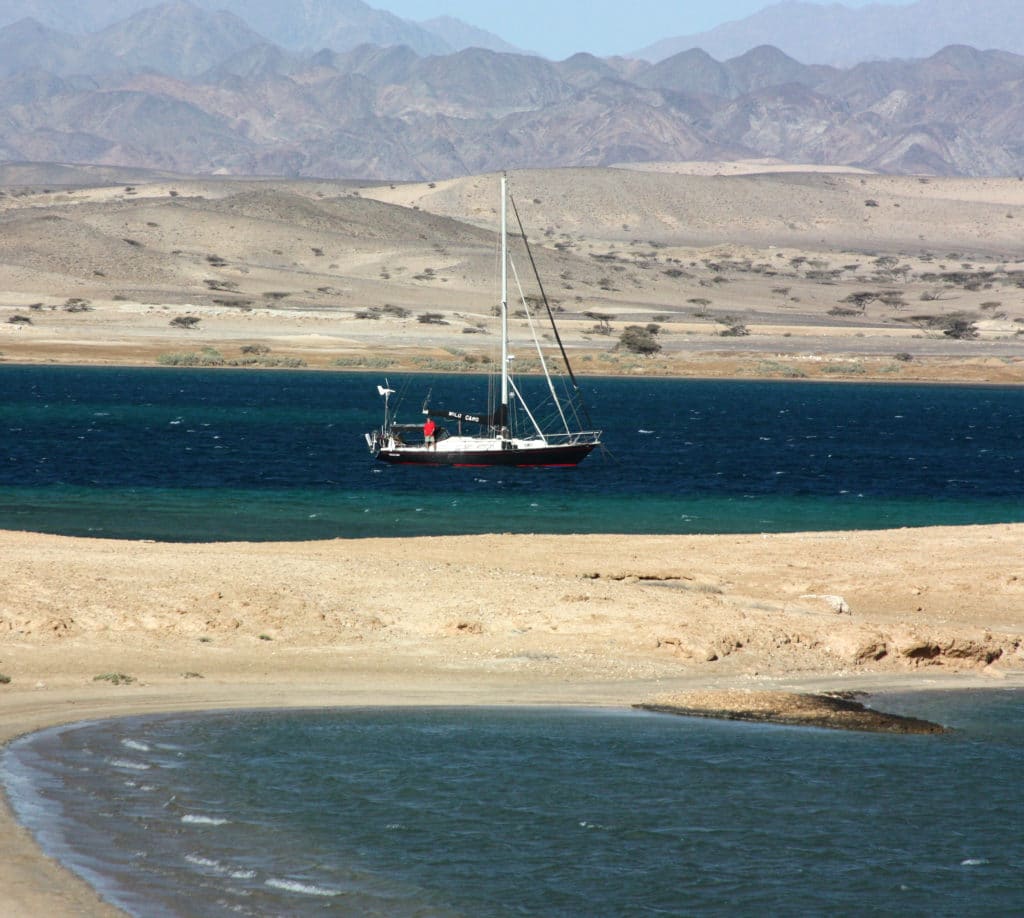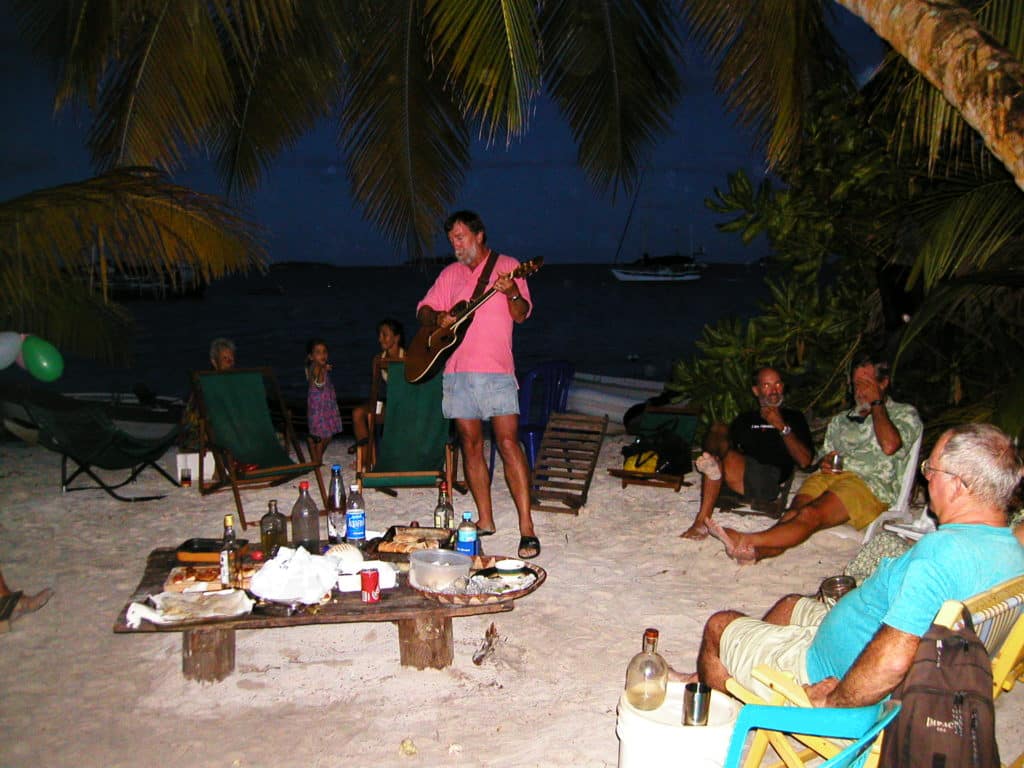
I am a child of the Atlantic Ocean, in all its chilly, fog-shrouded glory. This is the body of water that has nurtured me from Cape Town, South Africa, to jolly ol’ England, and from New England to the Panama Canal. The Atlantic is a cruel mistress and a stern taskmaster, but I adore her vast indifference. The Pacific Ocean — especially transiting Polynesia — is a sun-kissed joyride by comparison. Things are easy on the Coconut Milk Run. Years disappear. Laughing island children are like mini gods, the women like sensuous goddesses. Even the pareo-clad men are drop-dead gorgeous.
But it is the monsoonal Indian Ocean that is my favorite: totally untamed and a place where all bets are off. There are no Caribbean or Mediterranean seas in which to catch your breath. No too-cute islands or gaudily colored cruise ships. In the Indian Ocean, there is no salesman’s hype; there’s just the sea, the wind, and a world-famous swell that hasn’t lain down since Eve tossed Adam the apple.
Nowadays, 239 people don’t drop from the sky and become lost in the Atlantic or Pacific, but the Indian Ocean will swallow them whole, as it did with Malaysia Airlines Flight 370, a mystery that remains unsolved two and a half years later. While someday our technology will tame this vast and watery expanse, I can only pray it isn’t in my lifetime. The Indian Ocean is the one place left to truly test yourself, the last place on earth where you can stare King Neptune directly in the eye.
Just the exotic names thrill my adventure-seeking soul: Malaysia, Thailand, Myanmar, Bangladesh, India, Pakistan, Iran, Oman, Yemen, Somalia, Zanzibar, Kenya, Tanzania, Mozambique, Mayotte. There’s not a single prepackaged, sanitized, Walt Disney-cursed country among them. The Indian Ocean is wild, crazy and completely untamed — and so am I.
We’re currently wrapping up two years of cruising Southeast Asia. This will be our third crossing of the Indian Ocean, so the question is simple: Onward via the Red Sea or the Cape of Good Hope?
Either way, a cruising yacht is going to experience heavy weather — of the climatic kind on the run to Cape Town, or the political type off Somalia and up the Red Sea, through Egypt, and into the Mediterranean.
The Red Sea route has many advantages. For one, the weather is generally benign. There’s no ocean swell. Best of all, at the end lies the glorious Med, where the well-heeled yachtie finds cruising perfection.
The 36-foot catamaran Sophie just completed a 3,500-mile passage from the Maldives to Egypt, but she carried 500 gallons of fuel on deck in bladder tanks, and three professional, heavily armed mercenaries aboard. They had a lovely trip. More power to ’em, as we used to say.
However, carrying all that diesel on deck presents its own set of problems, as does sharing your living space with three muscle-bound soldiers of fortune and enough armament to blow up a moderate-size country. Plus, there’s the considerable expense of maintaining a personal navy, no matter how small. And the Mideast is getting less stable, not more. Oman was once a good place to re-provision, but now the reported corruption at the Port of Salalah has become prohibitive. Aden is a no-go; it has fallen to the Islamic State. Sudan is still at war. And the money-jackals of Egypt and the Suez Canal have become more empowered since the Arab Spring, not less.
In comparison to Sophie’s crossing, our Indian Ocean transit plan is a bit more low-key, by choice, and a lot cheaper, by necessity. We’ll go southward after visiting India, taking the Cape of Good Hope route. We prefer to wrestle with Mother Nature rather than mankind.
Timing is critical in the northern monsoonal Indian Ocean, where the winds blow east to west early in the year, from January to March, and west to east late in the year, from July to September.
Because of this, we’ve found, all the cruising yachts gather in Nai Harn, Thailand, to celebrate Christmas and New Year’s. There is a huge party of circumnavigators, who arrive from all points of the compass on various craft. We all catch up on our divergent cruises. We also collectively light our sky lanterns from the foredeck and allow our cares and woes to float away on New Year’s Eve.
Once the easterly monsoon is firmly established in early to mid-January, the whole fleet takes off and then fans out around the Nicobar Islands, bound for India, Sri Lanka and the Maldives.
Those vessels on the Red Sea run continue westward into the (hopefully) empty ocean, bound for either Oman, Djibouti, Eritrea, Sudan or Egypt, about 3,500 miles away.

Those of us heading for the Cape of Storms (the name the sailors of yore had for the Cape of Good Hope) meander down the Maldives from Kochi or Sri Lanka, and then hop down to the deserted Chagos for a month or two. (If you’re contemplating a similar voyage, check online for the latest regulations pertaining to stopping in the British Indian Ocean Territory of Chagos; they change rapidly.)
In May or June, once the trade winds in the Southern Hemisphere fill in around the Chagos, vessels then sail southwestward across the Indian Ocean to the Seychelles or Madagascar. Traditionally, the Seychelles were the preferred choice, but then Somali pirates started stationing motherships just offshore and took all the fun out of those lovely isles. So instead we intend to head south-southwest from Chagos until we’re on a line of latitude 15 miles south of the northern tip of Madagascar, then bang a right and head due west.
That’s the trick: Don’t aim at the northern tip of Madagascar. Weatherwise, South African yachtsmen say this is a “no-go zone.” Instead, they’ll tell you, approach Madagascar from the east, 15 miles to the south of the northern tip, and sail up as close as possible to the shore, so you almost “drag a toe on the beach,” as the locals recommend.
Why? Two currents collide at the island’s north coast, the Agulhas and the East Equatorial. Coupled with the 40 knots of breeze frequently produced by the massive, mountainous wind fence of Madagascar, they can kick up an extreme sea. Every year, numerous boats broach or pitch-pole in this area, earning it the no-go label.
On our last circumnavigation, we took a similar approach, with a Jeanneau 36 sailing a couple of hours ahead of our Hughes 38, Wild Card, and a CT 37 double-ender two hours astern. The Jeanneau 36 had an eventful passage, and we had an extremely exciting time of it as we hit 14 and 18 knots, respectively, while surfing down the crests of 30-foot seas. The CT 37 broached and flipped upside down, its massive keel pointed skyward for many minutes as helmswoman Denise Schepens treaded water alongside, wondering whether to cast off her safety harness.
Once around the tip, though, the seas go from maelstrom to flat calm in the blink of an eye, exactly as if God shut off the fan.
While stopping in the Seychelles eliminates the need to sail through this challenging patch of water, you’ll be hard on the wind the whole way to Madagascar, with deck-sweeper after deck-sweeper testing your gear. Our friends John and Jane, on Barnacle B, took this route and got a lot of water below deck when their dodger pretzeled under a massive boarding wave.
Yes, the southern Indian Ocean is feisty by any measure.
Most of the cruising fleet hangs in Madagascar for a bit, being chased up bilbao trees by laughing lemurs. Other cruisers adjourn to nearby French Mayotte, where the cruising wives gather for their morning espressos within view of the French Foreign Legionnaires, dressed stylishly in their hot-pants uniforms, performing their morning calisthenics.
Vessels departing from Australia’s Torres Strait and bound for Christmas, Cocos Keeling, Mauritius, Réunion and then Richards Bay, South Africa, have no easier a time of it, for there is always one gale (if not two) lurking between Réunion and the African continent.
“It’s not a matter of if you get nailed,” says my friend Steve Macek, of the three-masted Herreshoff Star of Nevis, “but how hard and how many times.” In a nutshell, as you approach the western Indian Ocean, you have a very active weather picture, with extremely fast and massive ocean currents.
Here’s what happens during a classic sou’westerly gale: Prior to the blow, the north winds run to the south and reinforce the 4- to 7- knot ocean current, building a massive, long-period swell. As the wind and seas approach the vicinity of the Cape of Good Hope, however, it’s not uncommon for the wind and barometer to drop precipitously for about 45 minutes. Then, wham! Forty to 60 knots from the southwest. This almost instantly humps up the sea to scary heights that can break freighters in half when they founder in the steep crests and deep troughs. This is the only place I have ever sailed where they regularly report “phenomenal seas” during marine weather reports, indicating waves higher than 60 feet. If you want to practice broaching, rollovers and pitch-poling, this is the place.
Once you’re safely in Richards Bay and have stopped shaking (this can take weeks), the rest of the passage through the Indian Ocean is relatively easy if you pay attention to the local marine weather forecasts. We’ll aim for Thanksgiving in Richards Bay and Christmas in Cape Town.
Given the many routing considerations, transiting the Indian Ocean via the Great Cape becomes a leisurely yearlong project rather than a feared three-month dash up the Red Sea.
Crime ashore in South Africa, however, is a real problem. We never went a day off the boat without witnessing a violent crime. Once I even had to dance out in front of our daughter, Roma, and Carolyn as a laughing murderer with a large, dripping knife skipped by.
That aside, Cape Town is one of the most visually dramatic ports we’ve visited, especially when the famed “Doctor” is in at Table Mountain, and the white clouds pour down its hillsides like smoke from an upside-down fire. Once you see the so-called tablecloth, you’ll never forget it. If you’re feeling particularly chipper, join in the Cape Town Yacht Club’s Wednesday night races, though they’re actually more demolition derby than speed contest. The bottom line is this: The Atlantic and Pacific oceans are sort of starter oceans compared with the Indian. It is the real deal. Before we depart, we’ll inspect Ganesh and be sure our storm and safety gear is all up to snuff. And for good measure, we’ll update our last will and testament. Seamanship isn’t an option here; it is a requirement.
As fall unfolds, Cap’n Fatty and Carolyn continue preparing Ganesh for the long dash to Cape Town.








